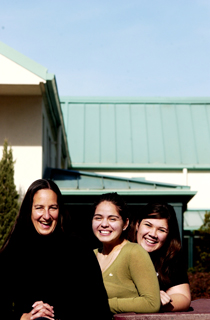
School embraces the notion of equity
Making friends at school should be simple for Zoa Lopez.
The pretty Anzar High School senior has a great smile, an
energetic attitude and a welcoming personality. It’s easy to
imagine her having a lot of friends, hanging out with just about
anyone she wants
– being of mixed race, Lopez could fit in with both white and
Latino students. Race shouldn’t be an issue.
School embraces the notion of equity
Making friends at school should be simple for Zoa Lopez.
The pretty Anzar High School senior has a great smile, an energetic attitude and a welcoming personality. It’s easy to imagine her having a lot of friends, hanging out with just about anyone she wants – being of mixed race, Lopez could fit in with both white and Latino students. Race shouldn’t be an issue.
Except in many cases, it is. And for a while, it was for Lopez as well.
“I get it from both sides,” said Lopez, who transferred to Anzar from San Benito High School two years ago. “I don’t speak Spanish fluently, so I’ll hear I’m not Mexican enough. To my white friends, I’m Mexican, and to my Mexican friends, I’m white. It’s hard being both.”
But rather than ignore one heritage in favor of the other, Lopez is learning to embrace both of them, thanks in part to Anzar’s staff and their commitment to creating equity among all students in all areas regardless of race. This focus on their students’ perceptions of racism has created a better awareness of, and how to accept each other’s identities, Lopez said.
“In a lot of other schools, teachers think that being color blind is the right thing to do,” she added. “But we need to embrace each other. We can’t continue hating each other because of the color of our skin. It’s just silly.”
Paying attention to both sides
Anzar High School staff has always considered its mission as more than getting kids to graduate. At Anzar, which was recognized as a California Distinguished School in 2005, there is a focus on individual needs rather than the student body as a whole. Instead of counselors working with a large number of students, the norm at most high schools, Anzar approaches student guidance a bit differently. Each staff member also acts as an adviser, working with groups of about 20 students over a four-year period. Advisers meet with their students every single school day, and students have the same adviser during his or her entire time at Anzar.
This advisory program used by Anzar has helped staff and students deal with racial issues as well as academic ones, Principal Charlene McKowen said.
“A relationship develops between adviser, student and parent that is super, and having an adviser means students always have an adult advocate in their lives,” she said. “It also means the adviser watches each student develop and grow and knows about issues in their lives. In that way they are able to give bona fide helpful advice in many areas.”
The staff also routinely participates in development days, during which a wide range of topics are covered – curriculum, test scores, required exhibition projects, and for the last 10 years or so, creating an anti-racist atmosphere both in the classroom and on campus.
“Our entire staff wants to make sure that any major decisions which affect students will be made with the equity lens flipped on,” McKowen said. “We stop and think ‘will this [decision] affect students of color differently?’ It means paying attention to both sides.”
Early in Anzar’s 14-year existence, staff members decided to move beyond accepted tolerance programs and look at how race affects students in all areas. They reviewed studies which showed that nationwide, middle-class African-American students still tend to score lower on the SAT than the lowest socio-economic level of white students, and determined that race really does matter, McKowen said.
“We were very harsh critics of ourselves; we looked at how we were presenting curriculum and dealing with students,” she said. “We learned that schools are taught in a very white way. We did a lot of training and then took it into the classroom.”
To that end, Anzar teachers now look at their lesson plans with a new goal in mind – making sure the curriculum can be understood by all students, regardless of race, McKowen said.
“We have actually investigated a number of instructional strategies and determined that most are pretty white-based,” she said. “This thinking has infiltrated academics at all levels. Here, however, teachers are now looking at their methods and their plans and thinking ‘how will this lesson affect my Latino students?’ They are looking at their lessons plans with a different eye. It doesn’t mean we are dummying lessons down in any way, it just means we are looking at a lesson differently.”
To reach this level, it was also necessary for staff members to evaluate how different race factors in their own lives played a role in how they presented material to their students, McKowen said.
“The teachers themselves had to come to a certain place on the race spectrum,” she said. “We had to see how we felt and that meant a lot of looking inside ourselves. I don’t believe that adults can be effective change agents in the arena of equity if they haven’t first looked at themselves and figured out what their race means for them and how they operate because of it.”
Progress is being made, McKowen said – Hispanic students are taking on more leadership roles on campus, and just a few years ago, Anzar students’ scores on the state’s standardized tests showed no achievement gap between white and Latino students in the areas of mathematics and language arts. And while more recent scores show the gap has returned, it is lessening, McKowen said.
Creating student leaders
Although there is a student leadership program at Anzar, it is not the typical elected-by-popular-vote student government program found at most other high schools.
Each of the school’s 16 staff members advises a group of about 20 students. Within that set-up, each advisory group selects one representative to act as a student leader; these leaders meet regularly to set up activities such as rallies.
Because each advisory group selects its own representative, McKowen said students who end up being leaders tend to do a good job.
“There is none of that stupid nominating process. Leadership is not a popularity contest here,” she said. “This way, we have equal representation at all grade levels and in the smaller groups, things can be discussed frankly and openly, and the students in a group can develop their own criteria for their leader and think about who can do the best job. It creates a lovely demographic that truly represents the school.”
After leaders are selected, those students get together regularly, and among themselves decide who will become commissioners of various duties, such as athletic events or executive decisions, similar to what is a student body president on other high school campuses.
Eliminating the electoral process has also created more diversity among student leaders, McKowen said.
“Our student leaders are role models,” she said. “The minute students of color are functioning alongside white students in the exact same capacity, we’ve accomplished something.”
Another difference between Anzar and other high schools is its service learning program – Anzar students are required to participate in a minimum of six semesters of working with a selected community service organization in some capacity. Many of Anzar’s Latino students have chosen to become mentors in the district’s ROMPE program. The acronym stands for Rompiendo Obstaculos Mientras Practicamos Español, which in English translates to Breaking Obstacles While Practicing Spanish. ROMPE allows students in second and third level Native Spanish Speaker classes to work with eighth-grade students at San Juan and Aromas schools who are also native Spanish speakers.
“We get quite a few kids coming in as ninth-graders who are carrying a big chip on their shoulders, and the idea that they can be an effective student leader is the furthest thing from their minds,” McKowen said. “We thought we could change that by using students as mentors, letting them create lesson plans and then actually teaching them. We discovered pretty quickly that K-8 kids see the student tutors as adults. It’s crazy, but it’s true.”
ROMPE’s curriculum is both cultural and historical based, where students are taught in their native Spanish. Art and theater projects also routinely find their way into the curriculum.
“The invaluable thing about this program is the kids see Spanish is a viable language, just as important as English,” McKowen said. “It’s just an amazing program.”
Senior Anita Mora, who is serving as a ROMPE mentor for the second year, says the program is also a great way to foster a better understanding between students of different races.
“I see some of those kids from last year now as freshmen, and I think it is good for them to see someone older that they know. It helps them feel comfortable,” she said. “I had some come up and ask me for advice. I wish I had had someone like that. It’s made me feel more comfortable about approaching others. I feel like I am a better leader because of it.”
Equity versus equality
Creating equity for all her students is an issue near and dear to McKowen’s heart. McKown herself comes from a multi-racial family; her father was Hispanic, while her mother is Caucasian. McKowen grew up in Venezuela, and lived among people with wide-ranging socio-economic status. But in spite of her father’s heritage and where she grew up, McKowen says she grew up not realizing she was a mixed race child.
“My parents talked to us constantly about all kinds of things, but not that,” she said. “It wasn’t until a moment during a workshop that I realized I had been raised more white, and I’m not sure why that was. All I can do is conjecture now, because my father has since died, but I wonder why. Somehow, he conceded parts of his culture and I’d love to ask him what made him decide to do so.”
In part because of her own history, McKowen said she believes it is important to be able to differentiate between equity among students and equality.
“For us, having an equity focus means more than eliminating the predictability of the achievement gap and looking at why certain subgroups score lower than others,” she said.
Anzar staff members are working to bridge that gap between equity and equality by creating an atmosphere where students feel safe enough to say what is on their minds.
“We have ‘Mix It Up Day,’ an exercise where students are forced to change roles,” McKowen said. “Through this exercise, they are put into situations they may never have faced before, such as being judged by their color. It’s when they are face to face with that sort of injustice that they begin to raise questions. It’s a beautiful lesson that life is not fair.”
The teachers themselves work on a similar exercise during their own staff development days, which helps them when conducting the same exercise with their students. It also helps staff realize how their own race has shaped the adult they have become, McKowen said.
“For white teachers, I think there has to be an understanding of what white privilege means. For teachers of color, it means understanding what baggage their race brings to the mix and letting go of it. For mixed races, it means understanding how their races mix and feeling comfortable with it.”
Understanding it doesn’t always make it easy to accept, however.
“In school, racism gives messages about who you can sit with or who you can hang out with,” Lopez said. “Like, just because I work with El Teatro Campesino, a lot of kids think I’m a chicana activist. Some think I’m too Mexican. But I’m luckier than other kids, because I look white.”
A continuing process
Creating a racial-free campus is an ongoing process – there are still the occasional conflicts between students of different cultural backgrounds, and staff members are continuously looking for ways to teach racial tolerance both in and out of the classroom.
“It’s not like we’ve tackled racism and won here by any means, but we are dealing with it head on,” McKowen said. “Everyone is moving in the right direction.”
For Zoa Lopez, moving in the right direction has meant accepting her Mexican-American heritage and learning to live with the many preconceived perceptions others may have of her. A major step in that process was completing a recent exhibition project.
Exhibitions are a gradution requirement at Anzar; students must complete both an oral and written presentation in several subject areas – language, arts, science, social science, service learning, math and a post-graduate plan. Lopez focused on what she had learned about tolerance by presenting an exhibition called “Why does race matter?” The presentation was centered on what the teenager says are her newfound beliefs about race, which were shaped mostly due to what she has learned on the subject since coming to Anzar.
Creating Equity
Anzar High School staff members are trying to create equity among students in the following ways:
– Conducting staff development days during which teachers work on creating curriculum which is not traditionally “white-based” while also learning to accept their own heritages.
– Presenting curriculum in ways that all students, regardless of race or socio-economic differences, can understand equally.
– Working with students in small groups in order to be adult advocates for each student
– Establishing a student leadership program which allows for students within a small advisory group to pick a representative for student government rather than holding school wide popular elections. This allows for a more equal representation of each different student group on campus, Principal Charlene McKowen said.
– Promoting various programs and activities such as ROMPE and “Mix It Up Day” where students are able to express themselves freely or act as mentors to other students.









